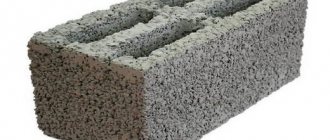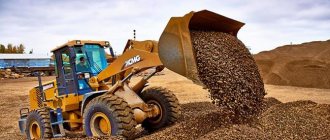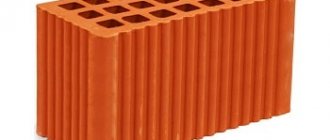Concrete is often delivered to construction sites in mixers. Ordering it is easier than preparing it yourself, since this process requires assistants and knowledge of the rules of kneading. When ordering a mixture, it is important for the client to know how many cubes are in the concrete mixer that was delivered to him, as this will affect the characteristics of the foundation, blocks, road surface or other structures and elements. It is also not uncommon for the quantity of concrete delivered by the supplier to be less than what was paid for.
Parameters of mobile mixers
The rules for transporting solutions using specialized machines are established in clause 9.1 of GOST 7473-2010. The mixer of a modern concrete mixer truck consists of a drum, inside of which blades are installed. Continuous rotation of the drum helps maintain the homogeneity of the concrete mixture.
There are models of concrete mixer trucks that allow you to prepare the mixture inside the machine while it is moving. But in Russian practice, the option of delivering a mixture mixed at the manufacturer is more often used.
Models of mixers of different sizes are common on the Russian market. Typically, concrete mixers from 3 m3 (for example, the Japanese model Hino Ranger Mixer) to 9 m3 (for example, Russian-made models of the TZA 58149 series based on the KAMAZ chassis) are used.
The volume of concrete transported often depends not only on the customer’s needs, but also on the permissible load on the roadway near the facility under construction. Thus, the total weight of the ten-cubic-meter concrete mixer truck MAN 35.322 is 35 tons, which does not allow it to move on city roads. Therefore, concrete is sometimes delivered with partially loaded mixers, which makes it difficult to estimate its volume.
How many cubes of concrete are in a KAMAZ mixer?
When calculating the cost of concrete, the cost of the material itself, its volume and transport component are taken into account. This calculation is the same for a private owner or a company; the difference lies in the need and ability to transport certain quantities of solution. For different volumes you can choose different transport.
Our customers are often interested in how much concrete can be delivered in a KAMAZ mixer in one trip. Domestic vehicles with standard lifting capacity are capable of transporting from 6 to 10 cubic meters of concrete. How much or little this is is difficult to judge - it all depends on the volume of the solution that will go into the prepared formwork.
Delivery costs are also affected by the need to pump concrete from the mixer. With a standard hose length of 1.5 - 2 meters, the possibility of moving the solution directly into the formwork is limited. There is usually an additional charge for using machines with longer sleeve lengths.
The price of a concrete mixer in Moscow usually consists of the main components:
- The total cost of concrete of a certain brand.
- Transportation distances (taking into account the location of the object relative to the Moscow Ring Road).
- The vehicle has additional equipment - a concrete pump, long hoses.
- When renting a mixer, the cost of its use is taken into account by the hour.
The ability of the car to deliver the solution to the site by road is also important - the weight of one cubic meter of concrete is on average 2.4 tons, which means that a car carrying approximately 7 cubic meters will create a load on the road of approximately 30 tons. It is especially important to take this parameter into account when delivering concrete to places where there are bridges and overpasses along the route.
Calculation of concrete by volume
You can find out how much concrete was delivered by calculating the volume of products, structures or their parts made from it. For example, when pouring a monolithic foundation layer-by-layer, you can calculate the volume of the delivered mixture (V, m3) using a simple formula:
V = h * S, where:
- h – change in the height of the foundation after pouring (m);
- S – cross-sectional area of the area limited by the formwork, in plan (m2).
The volume of the reinforcement can be neglected. The accuracy of such calculations depends on the quality of measurements of the cross-sectional area and changes in the height of the foundation. However, for some cases when the volume of the product is difficult to determine, this technique is not applicable. In addition, making claims for delivery with such a method for estimating volume will also be problematic, especially if the concrete is poured on sand or the formwork does not have sufficient rigidity and is deformed during pouring.
The lineup
The model line includes variations of vehicles that use various models of KamAZ trucks as a basis. This point largely determines the operational potential of the vehicle.
KamAZ 581453
The three-axle concrete mixer has a 6x4 wheel arrangement. The truck is equipped with a hydromechanical drive and a reliable power plant made in Germany. The planetary gearbox was manufactured in Italy. The main functional elements subject to the greatest wear are made using high-strength steel. This moment ensures the overall maximum service life of the machine. The model is designed for use throughout the year. This becomes possible due to the fact that the chassis engine heats the liquid in the water tank with exhaust gases.
Technical characteristics of the KamAZ 581453 concrete mixer:
| Characteristics | Indicators |
| Total weight, kg | 27500 |
| Load capacity, kg | 18900 |
| Basic chassis | KamAZ 6520 |
| Dimensions, mm: | |
| - length | 8600 |
| - height | 2500 |
| - width | 3800 |
| Water tank capacity, l | 450 |
| Mixing drum volume, m3 | 14 |
| Drum loading height, mm | 3800 |
| Unloading height, mm | 2200-500 |
| Mixing duration, min | 20 |
| Engine power, hp | 320 |
| Engine power, kW | 235 |
Photo of concrete mixer truck KamAZ-581453
KamAZ 58147s
This model is designed for operation in temperatures from -20 to +40 degrees. The concrete mixing plant is capable of functioning completely autonomously. This becomes possible thanks to the presence of an individual power plant and tank. The high pressure fuel pump is controlled using a flexible cable.
Technical characteristics of the KamAZ 58147s model:
| Characteristics | Indicators |
| Total weight, kg | 24000 |
| Basic chassis | KamAZ 53229 r |
| Dimensions, mm: | |
| - length | 9000 |
| - height | 2500 |
| - width | 3700 |
| Water tank capacity, l | 450 |
| Mixing drum volume, m3 | 12 |
| Drum loading height, mm | 3700 |
| Unloading height, mm | 2200-500 |
| Engine power, hp | 330 |
| Engine power, kW | 240 |
Photo of concrete mixer truck KamAZ-58147s
KamAZ-58145z
Such concrete mixer trucks are characterized by high productivity. The model is built on the KamAZ 65115 62 chassis. With a total weight of 27.5 tons, the maximum load capacity of the vehicle remains at 17 tons. A 300-horsepower unit capable of producing 225 kW is used as a power plant.
Specifications:
| Characteristics | Indicators |
| Total weight, kg | 27500 |
| Load capacity, kg | 17000 |
| Basic chassis | KamAZ 65115 62 |
| Water tank capacity, l | 800 |
| Mixing drum volume, m3 | 11 |
| Drum loading height, mm | 3690 |
| Unloading height, mm | 2200-500 |
| Engine power, hp | 300 |
| Engine power, kW | 225 |
Photo of concrete mixer truck KamAZ-58145z
KamAZ-581462
This model of concrete mixer based on KamAZ 53229r is used when it is necessary to deliver ready-made concrete mix while maintaining the properties of the product. The three-axle truck is equipped with a 330-horsepower component unit, capable of generating 240 kW. The torque remains at 1373 Nm. Technical characteristics of the KamAZ 681462 concrete mixer truck:
| Characteristics | Indicators |
| Total weight, kg | 24000 |
| Basic chassis | KamAZ 53229r |
| Dimensions, mm: | |
| - length | 7800 |
| - height | 2500 |
| - width | 3600 |
| Water tank capacity, l | 450 |
| Mixing drum volume, m3 | 10 |
| Drum loading height, mm | 3000 |
| Unloading height, mm | 2000-500 |
| Engine power, hp | 330 |
| Engine power, kW | 240 |
Photo of concrete mixer truck KamAZ-581462
KamAZ-69361n
Model 69361n is equipped with a hydromechanical drum drive. In this case, power is taken from a diesel power plant capable of operating in autonomous mode.
Calculation of concrete volume based on its mass
In most cases, the volume of concrete is calculated using the formula:
V = M / Q, where:
- M – mass of concrete (kg);
- Q – concrete density (kg/m3).
According to clause 2.10 of GOST 25192-2012, concrete is divided according to average density into the following types:
- especially heavy (more than 2500 kg/m3);
- heavy (2000-2500 kg/m3);
- light (800-2000 kg/m3);
- especially light (less than 800 kg/m3).
The grade of concrete based on average density is designated by the letter “D”, that is, a mixture of grade D2000 has an average density of 2000 kg/m3. According to clause 4.2 of GOST 25192-2012, the average density, like other quality indicators, must be indicated in technical documents.
You can find out the mass of the delivered concrete mixture by the difference in the masses of the loaded and empty concrete mixer truck. To do this, it is necessary to weigh it before and after unloading. At large facilities under construction, truck scales with a maximum load of 30 tons are installed to control incoming materials and products.
Purchasing such a device for private construction is unprofitable. If you do not have your own truck scales, the weighing procedure can be controlled at the factory from where the material will be delivered.
Advantages of a mixer
The first thing I took into account is that delivery can be organized in conjunction with draining the required volume. With the same success, you can rent it and then carry out the process of mixing concrete, but using your own components.
The resulting mass can be used to prepare a mortar consisting of cement and, of course, gravel. Well, and, perhaps, an important advantage of the mixture that can be obtained from a mixer, I would highlight the highest quality of the solution.
As I said earlier, quality is the key to the successful construction of structures, buildings, houses and everything else. Now you understand why you need to know how many cubes of concrete are in the mixer.
The video in the article will tell you about many of the nuances of working with the foundation and mixer.
Acceptance rules
The rules for acceptance of concrete mixtures are established by GOST 7473-2010. Thus, in paragraph 6.5 of the specified standard it is determined that mixtures are taken by weight or volume in accordance with the actual composition and actual average density. According to clause 11.2, the last two parameters must be indicated in the accompanying documents.
Therefore, if serious deviations occur between the ordered volume and the volume calculated using mass and density indicators, the customer has every reason to make a claim.
Organizing control of the volume of supplied concrete is quite difficult and for small batches it is unprofitable. Therefore, it is better to choose reliable suppliers and contact the manufacturers directly. It is necessary to draw up a supply agreement and monitor the availability of documentation on the quantity and quality of materials.
Return to list
Find out the cost of delivering concrete to your site
from our manager by phone or through the request form
Variations
The second variation, since the process will take place at a faster pace and is much simpler. But with all this, we must remember that the guarantee and service life of the structure depend on the quality of the material itself, and in this case, we have concrete, from which it follows that it must be very well mixed and, of course, comply with all standards and state quality standards, GOST and the like.
But before ordering concrete , you first of all need to know how many cubes (in volume) you need, namely, calculate how many cubes of concrete are in the mixer. And only then, carry out all subsequent actions.
Table of characteristics of concrete mixtures
| Class | Brand | Euro class | Mobility | Strength | Waterproof | Frost resistance | Rigidity |
| AT 10 | M150 | c8/10 | P2 - P4 | 163 kg/cm2 | W2 - W4 | F 50 | Zh1 – Zh4 |
| B15 | M200 | s12/15 | P2 - P4 | 196 kg/cm2 | W2 - W4 | F 100 | Zh1 – Zh4 |
| IN 20 | M250 | s16/20 | P2 - P4 | 275 kg/cm2 | W4 - W6 | F 150 | Zh1 – Zh4 |
| B22.5 | M300 | s18/22 | P2 - P4 | 296 kg/cm2 | W6 | F 200 | Zh2 - Zh4 |
| B25 | M350 | s20/25 | P2 - P4 | 337 kg/cm2 | W6 - W8 | F 200 | Zh2 - Zh4 |
| B30 | M400 | s25/30 | P3 - P5 | 392 kg/cm2 | W10 | F 300 | Zh3 - Zh4 |
| B35 | M450 | s30/37 | P3 - P5 | 458 kg/cm2 | W10 - W12 | F 200 - F300 | Zh3 - Zh4 |
| B40 | M550 | s32/40 | P3 - P5 | 524 kg/cm2 | W10 - W16 | F200 - F300 | Zh3 - Zh4 |
| B45 | M600 | s35/45 | P4 - P5 | 591 kg/cm2 | W12 - W18 | F200 - F400 | Zh3 - Zh4 |
Mixer with concrete pump: types and parameters of this type of construction equipment
A concrete pump mixer is a machine that is used to transport fresh, just-mixed concrete to a construction site. Such units are simply irreplaceable in the construction of such objects as residential and industrial buildings, bridges and tunnels.
The use of this technique allows us to significantly increase the speed of work with concrete, while simultaneously reducing the labor intensity of the pouring process.
In literature or other information sources you may come across terms such as:
- RLS;
- ABN;
- Concrete mixer truck;
- Pneumatic compressor;
- Concrete mixer;
- Truck-mounted concrete pump;
- Automotive concrete pump;
- Mixer concrete pump, etc.
Types of markings
Concrete differs in markings. There are options from M100 to M400. The figure shows how many kilograms per 1 cm2 the structure can withstand. Professionals advise choosing a higher indicator, since it has the necessary resistance to external damage and is able to serve for a long time and without interruption.
Marking is a guarantee that even in the case of heavy loads nothing bad will happen, and it will continue to be able to withstand heavy loads. During the construction process, a logical question arises: how many cubes of concrete are needed? This indicator is directly influenced by the final area of work, as well as the chosen marking. There are specialized calculators on the Internet that help calculate the required values.











